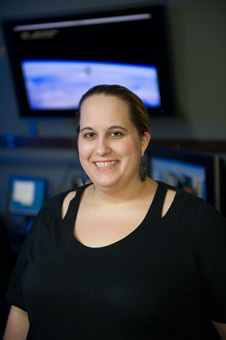Feature
Text Size
Meet Theresa Spaeth, Manager in the MPCV Avionics, Power, & Software (APS) Office at JSC
08.14.12

Theresa Spaeth, Manager in the MPCV Avionics, Power, & Software (APS) Office at JSC. Credit: NASA
This profile continues a series to introduce the people behind the development of Orion. The first space-bound Orion vehicle recently arrived at Kennedy Space Center in Florida from Michoud Assembly Facility in New Orleans. At Kennedy, the spacecraft will be outfitted for Exploration Flight Test-1 (EFT-1), planned for 2014. EFT-1 is an essential step that will allow engineers to acquire critical re-entry flight performance data and demonstrate early integration capabilities to prepare Orion for deep space exploration.Background:
Spaeth is a Houstonian, born and raised. Her Texas roots carried on through college where she obtained a bachelor’s and master’s degree in Aerospace Engineering from Texas A&M University.
Working on EFT-1
In regards to the importance of EFT-1, Spaeth feels “this will be the first flight test of the Orion avionics architecture and flight software, which will be the foundation for future Orion missions. In particular, she said the flight test will provide validation of that architecture as well as additional test data that will give us insight into potential modifications/improvements needed for EM-1 and EM-2.”
Her contribution to EFT-1 has been in influencing the architecture, design and implementation of the software as well as the integration of the data-supporting software. Spaeth said the software is an integral part of the highly automated EFT-1 mission “so we want to ensure that the code and data are appropriately integrated such that EFT-1 will be successful.”
Spaeth currently has two System Manager (SM) roles under the MPCV Avionics, Power and Software office. She is the Vehicle Systems Management (VSM) System Manager, which provides technical management and engineering support to the APS office for integrated areas such as mission sequencing, checkpoint/restart, and fault detection, isolation, and recovery. She recently became the Data Integration System Manager. Orion has highly reconfigurable, data-driven flight software in order to support vehicle and mission unique reconfiguration and to allow for maintenance/enhancement as knowledge of the vehicle operation evolves, Spaeth said.
“Under my Data Integration SM role, I work with the contractor to ensure data supporting software and other project needs is properly integrated and configuration controlled, which includes development of databases to house the data, tools to extract the data into a format used by flight software, plans for data validation prior to flight, etc.,” Spaeth said.
As a NASA software representative, she is embedded with the prime contractor to help in resolving integration issues and aid in better coordination between the NASA and contractor teams. In this role, she spends a week or two each month in Denver.
Working at JSC
Spaeth feels the most fulfilling part of her job is “working with the very talented technical team (NASA and contractor) as we progress through project lifecycle.”
On the flip side, the one part of her job that could be construed as her least favorite is the challenging budget and schedule environment. But the most interesting part of her job is the ever-changing nature of the project on which she works.
“There are new challenges each day so the work is never routine,” Spaeth said.
Outside the gates
Spaeth enjoys a variety of hobbies but jewelry making has become one of her latest favorites.
“Growing up, I always wanted to be a teacher, and I became captivated by human spaceflight while in high school,” Spaeth said. “I was lucky enough to combine both my passions (teaching and space) as a Space Shuttle instructor for a few years after undergraduate school.”
Her parents have been the biggest influence on her career path because “both are great problem solvers and have a passion for learning,” which inspired Spaeth to be an engineer.
NASA – past and future
Her best NASA memory so far was watching the STS-114 (return to flight) launch and knowing that she had a part in training that crew. Spaeth “hopes to have a clear NASA vision” for the next series of human spaceflight missions, which will hopefully include destinations beyond the moon.